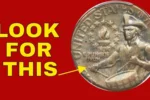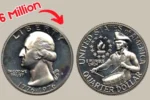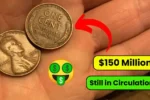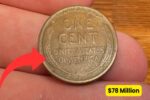Rare Dimes And Quarters Worth $672M? Here is How to Check Yours
The sound of coins rattling in your pocket might seem unremarkable, but don’t let it fool you—some of those ordinary-looking coins could actually be worth a fortune. While headlines boasting numbers like “$672 million” may seem like sensational clickbait, the reality is that certain rare dimes and quarters from America’s past can fetch jaw-dropping amounts that could truly change your life. I’ve spent years sorting through bags of change, and I’m here to pass along what I’ve discovered about these overlooked gems.
My passion for coin collecting was sparked the day my grandfather handed me an old buffalo nickel he’d kept since he was a boy. “Always check your change,” he’d tell me with a wink. Decades later, his words ring truer than ever—especially when it comes to dimes and quarters that might be sitting unnoticed in your change jar.
The Search for Numismatic Riches: What Makes Coins So Valuable
Before we dig into the specific coins to watch for, let’s take a look at what actually makes some dimes and quarters incredibly valuable:
Minting errors – These occur when a mistake happens during the production process, resulting in coins with oddities collectors love. Because they’re not supposed to exist, they’re often very rare.
Low mintage – Some coins were made in extremely small numbers due to historical events or minting decisions. The fewer there are, the more collectors want them.
State of preservation – A coin in mint condition can be worth many times more than the same one in worn shape. Uncirculated coins are especially prized.
Historical importance – Coins connected to significant periods or events in U.S. history often carry additional value beyond their rarity or condition.
Now let’s dive into the dimes and quarters that could potentially turn up in your pocket change—and change your life in the process.
Life-Changing Dimes You Might Still Find
The Famed 1894-S Barber Dime
The 1894-S Barber dime holds legendary status among collectors. Only 24 were struck at the San Francisco Mint, and just nine are known to still exist. The story behind it only adds to its mystique: The mint superintendent is believed to have made them as special gifts for banker friends, giving a few to his daughter with instructions to save them. According to legend, she spent one on ice cream on the way home!
In 2016, one sold at auction for a staggering $1.9 million. Even more intriguing? There’s a chance one or more of the unaccounted-for coins could still be floating around—possibly buried in a family collection or, though unlikely, still in everyday circulation.
The Coveted 1916-D Mercury Dime
The 1916-D Mercury dime is the holy grail for fans of the Mercury dime series. Just 264,000 were made at the Denver Mint—tiny compared to production at other mints that year. Denver was focused on making quarters instead, leaving this dime in short supply.
Well-preserved examples consistently sell for between $10,000 and $30,000. Even beat-up versions can bring in thousands. These occasionally surface in old coin stashes passed down through families, making them a thrilling potential find.
The 1942/1 Mercury Dime Overdate
This rare overdate error happened when a 1942 die was accidentally stamped over a 1941 die, creating a visible “1” beneath the “2.” It occurred at both the Philadelphia and Denver Mints.
The Philadelphia version (with no mint mark) often sells for $5,000 or more in decent shape, while the scarcer Denver version (with a “D” mint mark) can fetch upwards of $50,000 in top condition. A friend of mine once found a Philadelphia version tucked away in his dad’s old coin collection, completely unaware of its worth until he had it examined.
Valuable Quarters That Could Be Hiding in Plain Sight
The 1932-D and 1932-S Washington Quarters
The debut year of the Washington quarter saw two low-mintage runs from the Denver and San Francisco mints. Only 436,800 were produced in Denver and just 408,000 in San Francisco—the lowest mintages in the entire series.
These can be worth $5,000 to $15,000 in uncirculated condition. Even circulated ones can bring in a few hundred dollars. They’re often overlooked by beginners because they don’t look especially unusual.
The 1937 Double Die Obverse Washington Quarter
This rare error shows noticeable doubling on the date and the word “LIBERTY.” While not well known outside of dedicated collector circles, it’s a hidden gem.
In excellent shape, this quarter can bring in over $10,000. Even more worn examples regularly sell for $750 or more. Because awareness of this variety is low, it could be hiding in an old collection or pocket change right now.
Standing Liberty Quarter Errors (1916–1930)
Among the most exciting is the 1918/7-S overdate. This error occurred when a 1917 die was repunched with “1918,” leaving a clear “7” under the “8.”
These quarters regularly go for $15,000 or more in decent condition, and pristine ones can break six figures. Last summer, I met a woman who found one while cleaning out her late brother’s belongings—it ended up helping her retire comfortably.
How to Check Your Coins: A Step-by-Step Guide
Finding valuable coins takes time and attention to detail. Here’s how I do it:
1. Get the right tools
A good magnifier (7x to 10x zoom)
Bright lighting—natural light is best, but a strong lamp works too
Reference books or coin identification apps
Cotton gloves (to avoid skin oils damaging rare coins)
2. Know what to look for
Start with dates and mint marks (D for Denver, S for San Francisco, no mark = Philadelphia)
Check for overdates, doubling, or off-center features
Look for odd wear, or flaws that might be minting mistakes
Don’t forget to examine the coin’s edge and reeding
3. Where to search
Family coin collections
Bank rolls (older rolls are better)
Flea markets, estate sales
Coin star reject trays
That coffee can of change you’ve ignored for years
4. What to do if you find something valuable
Don’t clean it! Cleaning destroys value
Store it in a protective case or sleeve
Get it graded or authenticated by a reputable service
Check recent sales or auctions for current market value
I once scored a valuable 1955 double-die penny from a roll of wheat pennies I picked up at a bank. That kind of surprise never gets old—and it’s what keeps treasure hunters like me going.
The Truth About Rare Coin Headlines
Sure, those “$672 million” headlines are exaggerated—they usually represent the combined value of all known ultra-rare coins. But there’s still serious money to be made. Just last year, a contractor in New England found a 1794 Flowing Hair dollar hidden in the wall of an old home he was renovating. It later sold at auction for more than $800,000. It’s rare, but these discoveries do happen.
For me, coin collecting isn’t just about profit—it’s about history you can hold in your hand. A 1932 quarter isn’t just metal; it’s a piece of the Great Depression. Someone once used it to buy groceries or ride the streetcar. That connection to the past is priceless.
Starting Your Own Treasure Hunt
After decades in the hobby, here are a few tips I’ve picked up:
Knowledge matters more than gear. Learn before you spend.
Patience is key. Big finds take time.
Connect with other collectors. Most are happy to help.
Never clean a coin—just don’t.
Enjoy the process. The hunt is part of the fun.
Like my grandfather always told me, “Every coin has a story—you just have to know how to read it.” So the next time you get a handful of change or find an old box of coins in the attic, take a closer look. You might be holding a tiny piece of history… or something worth a small fortune.
FAQs: Rare Dimes & Quarters
How do I know if my coin is valuable?
Check the date, mint mark, and condition. Look for errors like doubling or overdates. Cross-reference with coin guides or apps.
Should I clean my coin before selling it?
No—cleaning can destroy value. Leave it as-is and handle it gently.
Where can I sell a valuable coin?
Go to a certified coin dealer, major auction house, or trusted online marketplace—after it’s authenticated.
Can modern coins be worth anything?
Absolutely. Errors in modern coins, especially state quarters or misprints, can be surprisingly valuable.
Should I get my coin graded?
If it could be worth $250 or more, it’s usually a smart move to have it professionally graded.











